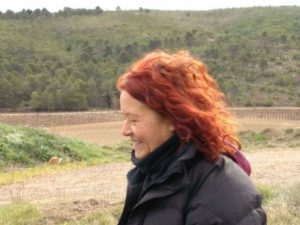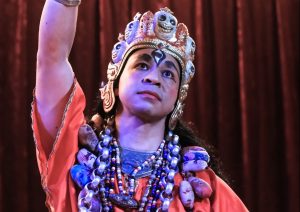This Fresh Existence is written by Cindy Rasicot about her beloved teacher Venerable Dhammananda. Published by Windhorse Publications in early 2024, this is an easy-to-read account of the life and experiences of the author and of Ven. Dhammananda as she transitioned from career woman, wife, and mother to monastic abbess against historical odds. The book also features a dedicated section on Ven. Dhammananda’s teachings in her own words.
In response to the COVID-19 pandemic, Rasicot created a virtual program called Casual Buddhism, through which participants could engage in one-on-one conversations with Ven. Dhammananda over Zoom. Part two of this book is predominantly the result of Rosicot’s private interviews and these public talks, meaning that as a resource book, one can skip straight to part two to access Ven. Dhammananda’s specific thoughts and lessons on a particular subject, should one wish.
After a family and successful career in front of TV cameras, Ven. Dhammananda Bhikkhuni, born Chatsumarn Kabilsingh, took a completely different path later in life where she faced—and ultimately broke through—gender barriers in Thai Buddhism. In 2003, she received full monastic ordination as a bhikkhuni in the Theravada tradition, becoming the first Thai woman to do so. Her mother, Voramai Kabilsingh, was also ordained as a bhikkhuni in Taiwan in 1971, which cast a light for Ven. Dhammananda’s path as she studied not only Theravada Buddhism, but also other world religions, including Christianity, as well as Tibetan and Mahayana Buddhism. She took the Bodhisattva Precepts from the Fo Guang Shan order in Taiwan, which gifted her with a larger educational perspective than many. Through her connection with Tibetan Buddhism, she has also had a long standing relationship with His Holiness the Dalai Lama, and their shared commitment to progressive Buddhism and inclusivity.
Here I would like to speak to the mothers and to those who have gone through life without realizing who they actually are, until a few decades have slipped away and the beckoning of awakening into a new chapter becomes louder: it is never too late.
And this is, in many ways, how we are introduced to this story; the new, life-affirming adventure that we never see coming.
These midlife existential moments can blindside many of us, including those who go on to become beacons of wisdom and compassion—especially after a full, modern life. Yet this may be exactly why these teachers become so accessible to contemporary ears. This Fresh Existence is an account of the intimate relationship between Ven. Dhammananda and Cindy Rasicot, and the history of the formidable ascent faced by one woman wanting to help pave the way for generations of Thai women following the path of Theravada Buddhism.
Historically, both male and female Theravada monastic orders thrived in Sri Lanka from the 3rd–11th centuries. However, during this period, Islamic invasions led to the decline and eventual extinction of the female lineage. The male monastic order survived, but the female lineage disappeared.
Fast forward to 1998, a significant year for Theravada bhikkhunis, and we find Ven. Dhammananda playing a pivotal role in this revival. An international ordination ceremony took place in Bodh Gaya, India, at the very site where the Buddha attained enlightenment. Chinese Mahayana monks and nuns ordained 20 Sri Lankan dasa sil mata (female renunciates, similar to the Thai mae chi) in the Mahayana tradition, the distinction between them being their monastic rules and practices based upon their origins—Theravada’s early Orthodox “Way of the Elders” followed by the “Great Vehicle” hundreds of years later.
However, this ceremony raised questions among Sri Lankan Theravada monks: could a woman ordained in the Mahayana tradition be recognized as valid from a Theravada viewpoint? Threats from the head of the Thai monastic sangha followed that sounded no different from the existential threats of a cult leader.
This book also raised my hackles regarding the gender conversation. While these may be my thoughts, the crux of the book, of Ven. Dhammananda’s life experience, is very much about gender.
This insistent gender ridiculousness simultaneously triggers, befuddles, and angers me. Firstly, on Earth, we require certain biology to maintain the species. So why is there such a war against those who physically push out the next generation? Second, consciousness and “proto-matter” (so to speak) has no gender that we know of, so why is this conversation held especially by those following a spiritual path?
We know that ancient Egypt valued balance, interconnectedness, and the roles of both principles. In ancient Celtic society, women held equal rank. In the viking world, women too were respected as equal, even if societal roles may have differed. So when people discuss the role of women in religion, they are really speaking of particular religious practices, which come with many social and cultural changes that pushed women lower and lower in social importance or even human value, let alone spiritual ability.
Now, maybe all this stemmed from masculine insecurity. Maybe from a testosterone drive, maybe boredom as the women were busy with the daily goings on, so the adult sons looked to expand their borders. Or maybe from a misconstrued idea of protection as borders were penetrated by others. Who knows for sure? But what we do know is that there seemed to be a dissolution of equality as patriarchy grew.
Maybe a mob of men couldn’t control themselves if a woman was to become part of a closed community, as in a religious one, which is why the Buddha was initially resistant then imposed such strict conditions when the first women sought ordination*—an argument offered by other high-ranking members of the Thai monastic sangha. Can’t men control themselves, I ask? Evidentially, this lack of impulse control is still a social problem around the world, however, outdated sanctions that cite the culture of the Buddha’s time rather than the actual prajna teachings he shared, speak to the ignorant rather than the enlightened mind.
And speaking of spiritual awareness, my long-standing thought, which was triggered as I read about Rasicot’s and Ven. Dhammananda’s childhood experiences with their mothers, and something I too related with, though mine extended into the expanded family in which I grew up. Parents, and adults in general, are still human and many are unconscious of the dichotomy between their words and actions. And. sadly. many spiritual folk are actively blind to the emotional harm they inflict on those closest when they place themselves in some spiritual ivory tower. Today, we might call it generational trauma as adult children address their personal psychologies with all the tools and awareness now at hand, and it hopefully leads to a deeper understanding and even forgiveness, and ultimately, healing. But I digress . . .
On one hand, This Fresh Existence tells the story of one woman’s grit against all odds in a world rife with misogyny. Simultaneously, it is a book of wise stories offered in a gentle and accessible way for any Buddhist neophyte. As well, it is Cindy’s story of her own ordination and her unquestioned faith in her teacher.
* See the wonderful book The Gathering by Vanessa R. Sasson.
See more
Cindy Rasicot
Casual Buddhism (YouTube)
Related features from BDG
Book Review: Gardens of Awakening by Kazuaki TanahashiBook Review: Tibetan Buddhism: A Guide to Contemplation, Meditation, and Transforming Your Mind by Khenpo Sodargye
Daughters of the Buddha: Progress on the Path of Female Ordination – A Conversation with Ven. Dhammananda Bhikkhuni
From Hearts to Hearts: An Interview with Ven. Dhammananda Bhikkhuni














